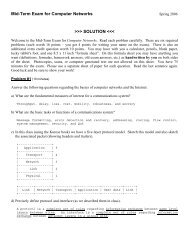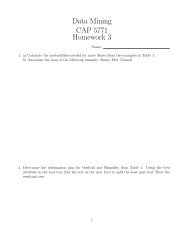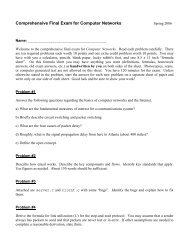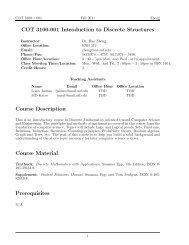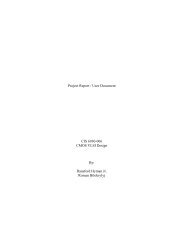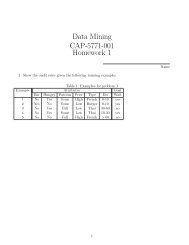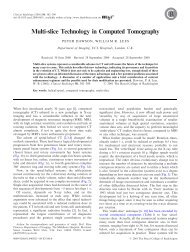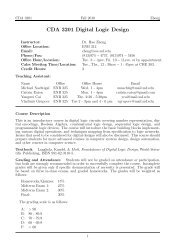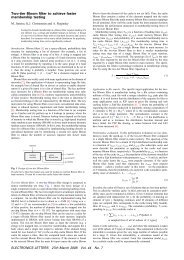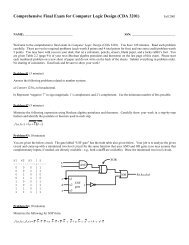The Generation of Fuzzy Rules from Decision Trees - Department of ...
The Generation of Fuzzy Rules from Decision Trees - Department of ...
The Generation of Fuzzy Rules from Decision Trees - Department of ...
Create successful ePaper yourself
Turn your PDF publications into a flip-book with our unique Google optimized e-Paper software.
Wind 75PlayFigure 1. A simple decision tree created by C4.5 <strong>from</strong> the examples in Table 1.2.1. Creating class labels<strong>The</strong> examples <strong>from</strong> which fuzzy rules will be created have continuous valued outputs. <strong>The</strong> C4.5decision tree algorithm requires crisp class assignments for all objects. It is necessary to partition thecontinuous output values into an effective set <strong>of</strong> discrete output classes. We use a modification <strong>of</strong> theapproach given in [21] to create output fuzzy sets. <strong>Fuzzy</strong> c-means (FCM) clustering [6] (with m=2) isdone on just the set <strong>of</strong> output values with variable numbers <strong>of</strong> clusters, denoted c in this paper. <strong>The</strong>partition validity metric [1]n∑ c∑S(c) = (u ik ) 2 (‖x k − v i ‖ 2 − ‖v i − x‖ 2 ) (1)k=1 i=1is used to determine the number <strong>of</strong> clusters c to use. <strong>The</strong> number <strong>of</strong> clusters, c, will correspond directlyto the number <strong>of</strong> classes in the FCG. In (1), u ik denotes the membership <strong>of</strong> the k th feature vector in thei th class or cluster, x k is the k th feature vector, v i is the i th cluster center and x is the average vectorcreated <strong>from</strong> the full set <strong>of</strong> feature vectors. <strong>The</strong> u ik ’s and v i ’s are obtained <strong>from</strong> first applying FCM(searching for c clusters) to the x k ’s.Clustering begins with c 0 = I with c 1 = c 0 + 1, c 2 = c 1 + 1, . . . and ends when S(c n ) > S(c n−1 ) withc n−1 ≥ c 0 . <strong>The</strong> usual case is I = 2, but to force finer grained partitions it is possible to set I > 2 andthis was done in some experiments.From our set <strong>of</strong> one dimensional feature vectors, c n fuzzy clusters are created within FCM. <strong>The</strong>yconsist <strong>of</strong> cluster centers v i , 1 ≤ i ≤ c n and membership values for each x k in the clusters representedby the v i ’s, which are contained in u ik . It is possible to create c n triangular fuzzy sets with each setcentered at one <strong>of</strong> the cluster centers v i . <strong>The</strong> spread <strong>of</strong> each symmetric fuzzy set is equal to twice thesmallest distance between any 2 cluster centers. Figure 2, shows the results <strong>of</strong> clustering 5 values into 2classes by showing the cluster centers and the associated triangular fuzzy sets. <strong>The</strong> largest 2 clusteredvalues (64, and 70) belong to centroid v2 with the smallest 3 belonging to v1.Since the clustering is one dimensional, we limit, each feature vector to membership in at most 2 classesor clusters. C4.5 requires that each training example presented to it belong to only 1 class. <strong>The</strong>refore, ourinitial approach is to create 5 possible classes to which a feature vector with some membership in class Aand class B may belong. If the membership <strong>of</strong> a feature vector is greater than 0.875 in A, it is assignedto class A. It belongs to class-A-B-25-75 if its membership in A is in [.125, .375), to class-A-B-50-50 ifits membership in A is in [.375, .625), and to class-A-B-75-25 if its membership in A is in [.625, .875). Ineach <strong>of</strong> our example instances the remaining membership would be in class B. <strong>The</strong>se joint classes can bedirectly implemented in terms <strong>of</strong> their component fuzzy sets representing class A and class B by usingfuzzy truth values in fuzzy CLIPS [17]. Joint classes will be further discussed in the next section.3



